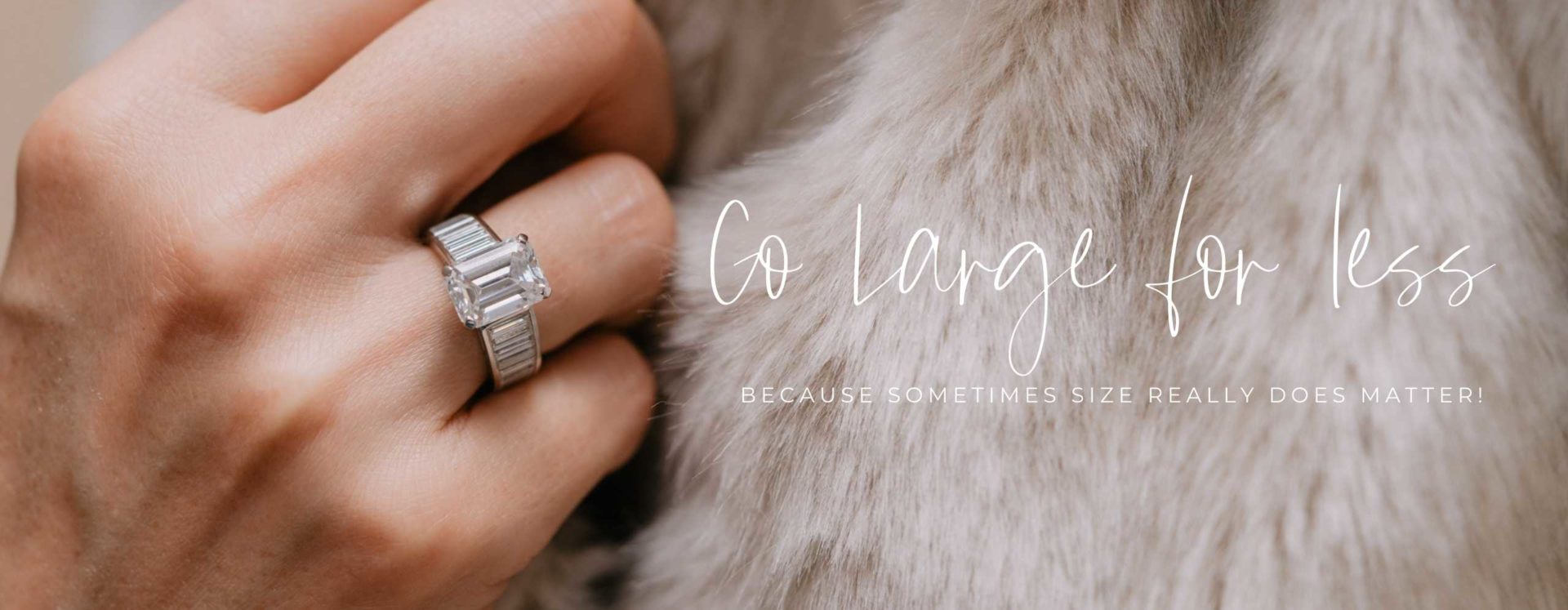Are lab grown diamonds too good to be true? Are they even real diamonds? Surely they can’t be if they haven’t come from the earth . . ?
These are just a few of the questions we often get asked. In all honesty we can see why people are hesitant about this which is why this blog should hopefully answer all your questions!
My name is Abi, I’m the photographer and website manager here at Ethica Diamonds and until I started working here, I too had never even heard of lab grown diamonds. In my mind, and as much as I didn’t like the idea of mining, you either got a mined diamond or a different stone from the earth.
Thank goodness technology and science has evolved and advanced enough for us to develop a way to create these beautiful stones without compromising on quality, look and more importantly the planet we call home.
Are lab grown diamonds real?
Having photographed a vast amount of jewellery set with lab grown diamonds I can safely say that lab grown diamonds are 1. Most definitely real and 2. Just as, if not more, gorgeous than mined diamonds!
In the most simple terms, a mined diamond is made up of carbon being exposed to extreme pressure and heat in the Earth’s crust over millions of years. A lab grown diamond can be produced in two ways: high pressure, high temperature (HPHT) and chemical vapour deposition (CVD). With HPHT, a ‘seed’ (a piece of diamond fragment) is placed with a block of carbon on top of it. Both are exposed to extreme heat and pressure just like they would be in the real world. With CVD, the seed is placed inside a sealed chamber that is heated to over 800 degrees celsius and filled with carbon-rich gases (typically methane and hydrogen). These gases are then ionised into plasma using a technology similar to lasers or microwaves. The ionisation breaks the molecular bonds in the gases, adhering the carbon to the diamond seed and slowly building up into a crystal, layer by layer.
According to the Federal Trade Commission in America (2018):
‘A diamond is a mineral consisting essentially of pure carbon crystallised in the isometric system.'
The FTC justified their change as follows: The final Guides therefore eliminate the word "natural" from the diamond definition. When the Commission first used this definition in 1956, there was only one type of diamond product on the market—natural stones mined from the earth. Since then, technological advances have made it possible to create diamonds in a laboratory. These stones have essentially the same optical, physical, and chemical properties as mined diamonds. 'Thus, they are diamond.’
What's wrong with mined diamonds?
As mentioned earlier, lab grown diamonds have the same composition and structure as a standard mined diamond but without the huge environmental or financial cost. Did you know that for every carat (yes, just 1.0 carat!) of diamond that is mined, nearly 100 sq ft of land is disturbed, almost 6000 lbs of mineral waste is created and 126 gallons of fresh water is needed. This disturbance of land leads to a real lack of diversity in the natural world due to the destruction of many habitats and the polluting of many water sources.
As well as habitat destruction and water pollution, diamond mines use a vast amount of electricity. A by-product of both electricity and hydrocarbon energy is the release of carbon emissions (CO2), which is a major contributor to global warming and climate change.
Not only does the diamond mining industry affect our environment, but also the people that work within it, particularly in poverty struck areas. In parts of Africa, some miners are earning a grand total of $1 a day. Working in unregulated conditions and risking their lives mining for stones that are going to be sold for thousands of dollars. Child labour at diamond mines increased by 50% in the months after schools were closed, according to the International Peace Information Service, an independent research service, which based its findings on the monitoring of 105 mines.
The country’s mining laws ban child labour, which is punishable with a fine and up to three years in jail, but enforcement is poor and authorities say they have minimal control over what happens in the mines. Bit depressing right?
Now I’m not going to sugar coat it and pretend that lab grown diamonds are harmless. Of course they’re not, but here at Ethica Diamonds, we do things differently to ensure that the lab grown diamonds we source are as environmentally friendly as possible.
The majority of our lab grown diamond suppliers are carbon-neutral, carbon negative or taking the necessary steps to become so. This means that either the production of their diamonds has no impact on the environment, or they go one step further and actually remove the bad carbon from the atmosphere with the production. The production of lab grown diamonds uses 18 gallons of water (seven times less than mining), disrupts just 0.07 sq feet of land (compared to 100 sq ft from mining), and a single pound of mineral waste.

Diamonds are never going to be ‘cheap’ so to speak, but due to the shorter supply chain, lab-grown diamonds can be anywhere from 20-30% less expensive than mined diamonds - in fact we’re seeing that percentage increase to around 50 or 60%! Why purchase a mined diamond when you can get an identical lab grown one with less impact on the environment or your bank balance?
Can a jeweller identify a lab grown diamond?
It's all well and good me saying this but is it easy to identify a lab grown diamond? Is it obvious they're not mined diamonds? Simply put, no. Due to lab grown diamonds being chemically identical, they are visually too. Even when tested on a diamond tester, lab grown diamonds test positive! Every diamond above 0.35ct, whether mined or lab grown, should have an inscription. The only way for a jeweller to identify a lab grown diamond is by using a ‘loupe’ (basically a magnifying glass) to inspect the inscription on the diamond.
For those who love the large carat look, lab grown diamonds are perfect. As previously mentioned, lab grown diamonds are substantially cheaper than mined diamonds. This means that you can get a larger carat diamond for much cheaper than you would pay for its mined counterpart. Just because the price is dramatically cheaper doesn’t mean the diamond quality is compromised in any way. The price difference is mainly down to the much shorter supply chain.
Large Carat Diamonds | 2.0ct 3.0ct 4.0ct 5.0ct 6.0ct | Ethica Diamonds
We fully understand that for some people, the idea of having a mined diamond is non-negotiable. Besides, gifting a mined diamond has been one of the best marketing campaigns of all time!
The downside, as discussed already, is of course the environmental and humanitarian destruction. We know we won’t be able to change everyone's opinion but we believe the more education that is out there for all to read, the more chance there is of us all having a positive impact on our planet.
Hopefully this answers your question and clarifies that yes, absolutely, lab grown diamonds are real diamonds!
Are you looking to have a lab grown diamond set in your jewellery? We would love to help you create your dream piece of jewellery that is affordable and better for the environment than traditional jewellery. With a large amount of different lab grown diamond options with a variety of carat sizes, cut, and colour, we would love to help you.
Get in touch here!
Read Next

The Senara Collection - Cornwall Inspired Jewellery That Makes A Difference
Ethica Diamonds is thrilled to unveil the Senara Collection, a stunning line of jewellery inspired by Cornwall's breathtaking landscapes, with a mission that goes beyond sparkle.

Kelvin & Clare's Engagement Story | A Proposal On The Jurassic Coast
Kelvin proposed to Clare on the Jurassic Coast with an ethical Piper engagement ring sample on the way down to beautiful St Mawes, Cornwall. He then surprised her with an appointment in our Truro showroom, where together they picked out the beautiful lab-grown diamond Felicia ring.





